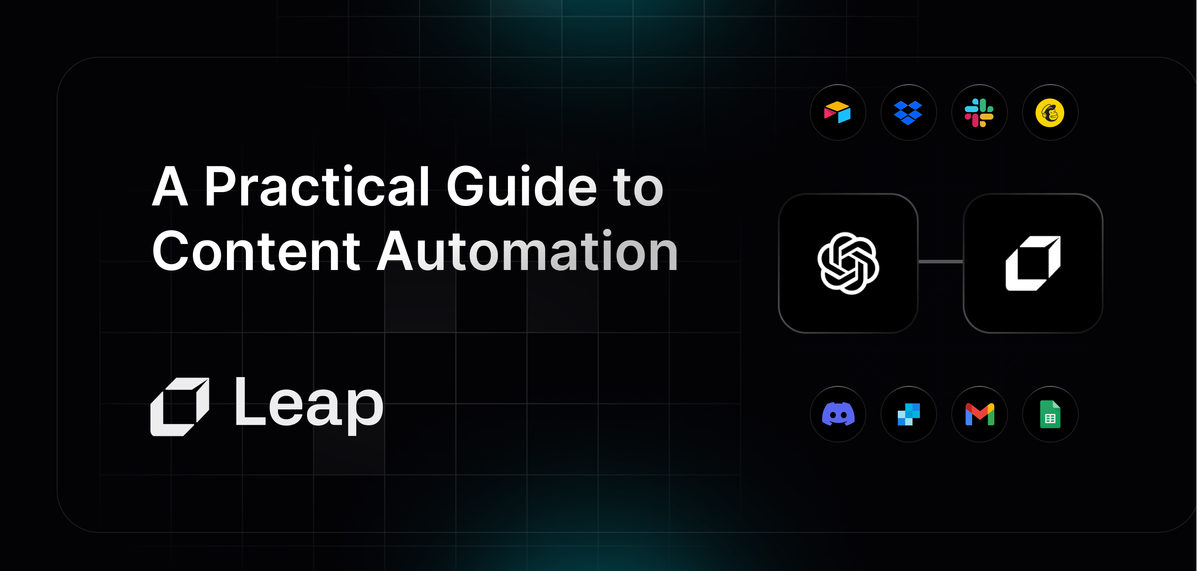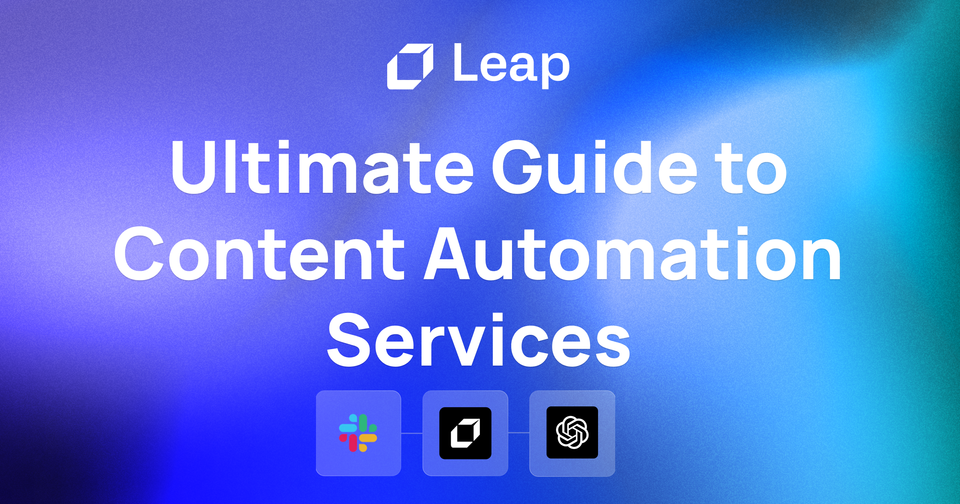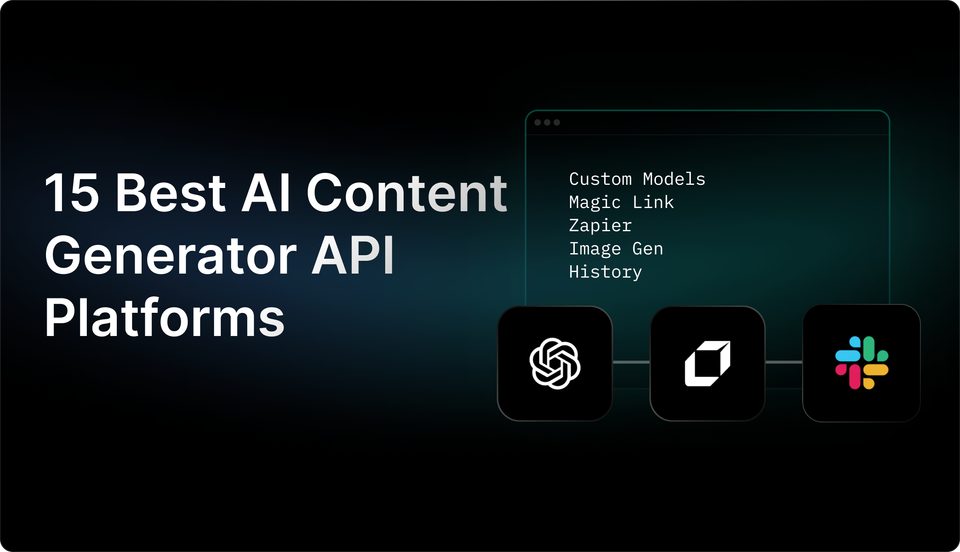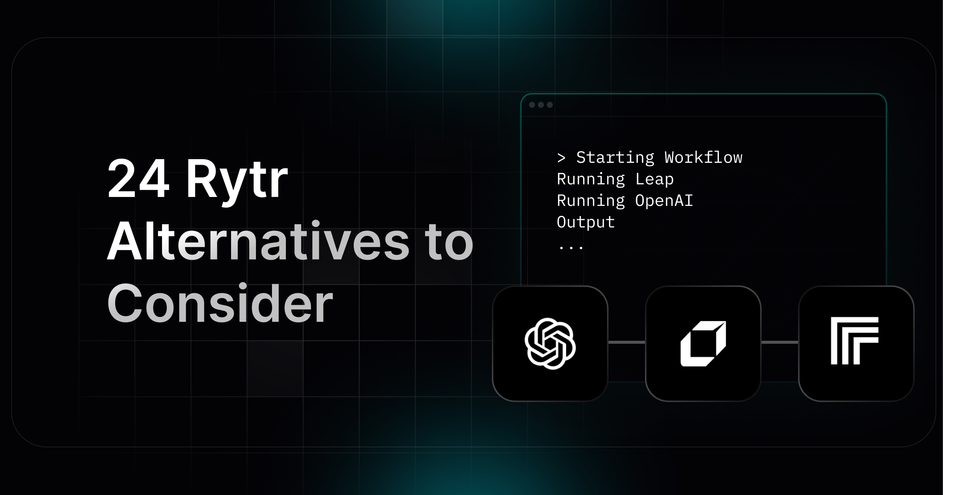A Practical Guide to Content Automation: Tools, Strategies, and Future Trends
Discover the latest tools, strategies, and future trends in content automation with this practical guide. Streamline your content creation process now.

Content automation is a game-changer in today's digital marketing landscape as it allows businesses to streamline their content creation process, reducing time and resources. This technology leverages algorithms to streamline various stages of content ideation, creation, and distribution, helping companies achieve better results with less effort. By implementing content automation, businesses can consistently produce high-quality content at scale, saving time and resources that can be redistributed to other critical areas of the business. If you're struggling to keep up with your content demands, this blog will shed light on how content automation can transform your content creation process.

What is Content Automation?

Content automation is the use of technology to streamline content creation processes. Delivering consistent, high-quality content to target audiences is essential for businesses. Creating this content manually can be resource-intensive and time-consuming. Traditional content creation processes require input from creative professionals every time content is needed. While this is crucial for maintaining quality, it can slow down the production process.
Challenges of Traditional Content Creation
Traditional content creation processes can be slow and costly. They often require creative professionals to brainstorm ideas, draft outlines, write content, and revise drafts before publishing.
This manual process is time-consuming and can introduce inconsistencies. Businesses need to keep up with the demands for content across many channels. To maintain these channels, businesses often need to scale their content production. This requires more resources to manage content creation and distribution across multiple platforms.
Content Automation
Content automation is a way to streamline content creation processes using technology. It uses machine learning and AI to automate repetitive tasks. This reduces the need for human intervention in the content creation process.
Automation can help businesses scale their content production by reducing the resources needed for content creation and distribution. It can also help maintain content quality and consistency across multiple channels.
Differentiate Between Content Automation and Content Creation
Automation is not a replacement for human creativity but a tool that can streamline processes. Content automation platforms can help businesses create and distribute content more efficiently. They can also help maintain quality and consistency across channels. By automating repetitive tasks, businesses can focus on higher-value work, such as strategy or creative thinking.
This can help businesses scale their content production while maintaining quality and consistency. Content automation differs from traditional content creation processes through its use of machine learning and AI to automate repetitive tasks. Businesses can use content automation tools to streamline content creation processes and distribute content across multiple channels.
AI Workflows: Streamline Content Creation with Leap
Leap helps you to automate your work with the power of AI. Partnered with Zapier, Vercel, and more, Leap enables you to supercharge your work by allowing you to create custom AI automations. Create sophisticated AI automations with no-code. Connect the tools you love with best-in-class AI text, image, and audio models.
Supercharge your existing tools with seamless AI integrations to OpenAI, Microsoft, and more. From summarizing documents, to voice translation, to AI call transcription, automate anything with Leap Workflows. The opportunities for automation are endless with Leap workflows.
Try Leap’s AI Workflows tool for free today.

What are the Common Content Automation Use Cases?

1. Creating Pitch Content
Content automation tools enable the automation of custom pitch content, eliminating the need for manual searching, pasting, and formatting. Leveraging tools like Pitchly can save time and effort, allowing for a more effective pitch-creation process.
2. Scaling Content with Data
Businesses can create scalable, branded, and customized content by leveraging existing data. By automating content creation processes, companies can efficiently support growth without the need for manual content creation.
3. Ensuring Brand Consistency
Content automation tools provide smart templates that help maintain brand consistency. These tools bridge the gap between data and content, ensuring real-time data-driven accuracy in content creation.
4. Marketing Content Optimization
Automation tools streamline the process of creating various data-driven content types such as deal tombstones, case studies, team bios, CVs, and more. This enhances marketing content effectiveness by automating and optimizing the content creation process.
5. Enhancing Marketing Strategies
Content automation tools play a crucial role in marketing by automating tactics, creating customer workflows, and efficiently generating large amounts of content. This is especially beneficial for small businesses looking to scale their marketing efforts.
6. Improving Customer Experience and Lead Generation
Automation tools enhance the customer experience, generate better quality leads, and ensure content reaches the right audience at the right time. This ultimately improves lead conversion rates and boosts customer satisfaction.
7. Streamlining Content Operations
Businesses can use content automation to share and distribute content across departments and platforms. This improves operational efficiency, enhances content consistency, and helps streamline content operations
8. Scalability in Content Distribution
Content automation enables scalable distribution across multiple platforms, ensuring content reaches the audience at optimal times. This increases engagement and reach by delivering content when it is most likely to resonate with the audience.
9. Real-Time Content Adaptation
Advanced content automation tools offer real-time adaptation features, automatically updating content based on new data, trends, or audience feedback. This ensures that content remains relevant and up-to-date at all times.
10. Personalized User Experiences
Content automation tools deliver personalized content experiences by analyzing user data and tailoring content to individual preferences. This enhances engagement and user experience by providing content that resonates with each user on a personal level.
Leap Helps You Automate Your Work with AI Workflows
Leap helps you to automate your work with the power of AI. Partnered with Zapier, Vercel, and more, Leap enables you to supercharge your work by allowing you to create custom AI automations. Create sophisticated AI automations with no-code. Connect the tools you love with best-in-class AI text, image, and audio models.
Supercharge your existing tools with seamless AI integrations to OpenAI, Microsoft, and more. From summarizing documents, to voice translation, to AI call transcription, to AI avatar and asset generation, to SEO automation, to even automating the cold email creation and sending process, automate anything with Leap Workflows. The opportunities for automation are endless with Leap workflows.
Try Leap’s AI Workflows tool for free today.
Related Reading
Types of Content Automation Tools

Content Generation Tools
Leap helps you to automate your work with the power of AI. Partnered with Zapier, Vercel, and more, Leap enables you to supercharge your work by allowing you to create custom AI automations. Create sophisticated AI automations with no-code. Connect the tools you love with best-in-class AI text, image, and audio models.
Supercharge your existing tools with seamless AI integrations to OpenAI, Microsoft, and more. From summarizing documents, to voice translation, to AI call transcription, to AI avatar and asset generation, to SEO automation, to even automating the cold email creation and sending process, automate anything with Leap Workflows. The opportunities for automation are endless with Leap workflows.
Try Leap’s AI Workflows tool for free today.
Enhancing Content Creation with AI Writing Assistants
AI writing assistants like Jasper, Content At Scale, and ChatGPT leverage artificial intelligence to assist in content creation. These tools help by generating high-quality content quickly and efficiently. Content spinners, on the other hand, can take existing content and rewrite it to create unique versions, offering a way to scale content production.
Content Curation and Aggregation Tools
Tools like BuzzSumo curate and organize relevant content from various sources and present it in a digestible format. These tools help content marketers stay updated with trending topics and ensure the content they create remains relevant and engaging.
Content Scheduling and Distribution Tools
Content automation tools like Hootsuite and Later automate the scheduling and distribution of content across multiple channels. By using these tools, marketers can plan and organize their content calendars in advance, ensuring a steady stream of posts and engagement with the audience.
Content Optimization and Personalization Tools
Tools such as Headline Studio and Semrush help optimize content for better search engine performance. Canva assists in personalizing visual content, allowing marketers to create engaging graphics tailored to their audience's preferences, leading to higher engagement rates and conversions.
Analytics and Reporting Tools
Analytics and reporting tools like Google Search Console, Rival IQ, Iconosquare, Zoho Social, and Sendible provide valuable insights into content performance. Marketers can use these tools to measure the effectiveness of their content strategies and make data-driven decisions to improve their campaigns.
How to Implement Content Automation Effectively

It's essential to begin by identifying your content needs and goals. Before you start automating your content, take some time to analyze what types of content you need to produce and why you need to produce it.
1. Identify your business and marketing goals and the target audiences you're trying to reach.
2. Make a plan for the different types of content you need to produce to meet those goals.
3. One of the best ways to automate your content is to create templates and outlines for different types of content that you produce regularly.
This way, you can automate the process without losing a personal touch.
Evaluate and select the right content automation tools for your business
After identifying your content needs and goals, you need to evaluate and select the right content automation tools for your business. There are many different tools and services that can help you automate your content. Automation tools can help you streamline your workflow, manage content resources, and deliver consistent, high-quality content. You can find a tool for every content automation use case, from content creation to content distribution. Depending on your goals and needs, you might use multiple tools or an integrated solution that meets all of your needs.
Integrate content automation tools into your existing workflow
Once you've identified your content needs and goals and selected the right automation tools, it's time to integrate those tools into your existing workflow. The goal is to streamline your content production process by automating the repetitive, time-consuming tasks.
Make sure your team is on board with the changes and understands how the tools work. Give your team time to get familiar with the tools and provide training to help them use the tools effectively. By integrating your tools into your existing workflow, you can minimize disruption and make the transition to content automation as smooth as possible.
Train your team on using the tools effectively
After integrating content automation tools into your existing workflow, it's crucial to train your team on using the tools effectively. Make sure your team understands the benefits of using the tools and how the tools can help them create better content faster.
Many automation tools offer tutorials and support to help you get started. You may also want to provide additional training or resources to help your team get the most out of the tools. By training your team on using the tools effectively, you can ensure a successful content automation implementation.
Monitor and adjust your content automation strategy as needed
Always monitor and adjust your content automation strategy as needed. It's essential to regularly review your content automation strategy and make adjustments as needed.
By tracking key metrics and monitoring the performance of your automated content, you can identify areas for improvement and make changes to improve your content automation strategy. By continuously monitoring and adjusting your content automation strategy, you can ensure that your automated content continues to meet your goals and deliver results.
Key Features to Look for in a Content Automation Tool

Automated content creation tools are essential for streamlining content creation processes by simplifying content generation through templates and predefined formats. These tools help in saving time and effort when creating content.
Efficient Content Management
Content automation platforms with efficient content management capabilities offer a centralized repository for storing and managing content. This ensures that content is organized, easily accessible, and enables collaboration, version control, and workflows.
Workflow Automation
Workflow automation tools define rules and processes for content creation, review, and approval, automating workflows. This feature ensures consistency, reduces manual tasks, and enhances efficiency in the content creation process.
Multi-channel Publishing
Content automation tools with multi-channel publishing capabilities facilitate the simultaneous publishing of content across various channels like websites, social media, and mobile apps. This feature streamlines content distribution across different platforms.
Analytics and Insights
Content automation platforms providing analytics and reporting capabilities offer valuable insights into content performance, customer engagement, and data-driven decision-making. These insights help optimize content strategies for better results.
Seamless Integration
Content automation systems with seamless integration capabilities with existing platforms like content management systems (CMS) and customer relationship management (CRM) systems ensure efficient content creation, management, and publishing processes.
Third-party Integrations
Support for third-party integrations in content automation tools connects the system with other tools or platforms, enhancing functionality and improving the overall content management experience.
API Access
API access is a crucial feature that allows interaction with other software applications, streamlines workflows, and provides a centralized hub for information. This feature empowers users to automate tasks and customize the system according to specific needs.
Content Optimization Features
Content automation platforms offering optimization tools for SEO, readability, and engagement metrics ensure that content is well-optimized for search engines and user interaction. This feature improves content performance and visibility.
AI Workflows
Leap helps you to automate your work with the power of AI. Partnered with Zapier, Vercel, and more, Leap enables you to supercharge your work by allowing you to create custom AI automations. Create sophisticated AI automations with no-code. Connect the tools you love with best-in-class AI text, image, and audio models.
Supercharge your existing tools with seamless AI integrations to OpenAI, Microsoft, and more. From summarizing documents, to voice translation, to AI call transcription, to AI avatar and asset generation, to SEO automation, to even automating the cold email creation and sending process, automate anything with Leap Workflows. The opportunities for automation are endless with Leap workflows.
Try Leap’s AI Workflows tool for free today.
Related Reading
- Content Scaling
- Content Workflow
- Content Marketing Automation
- How To Make Ai Content Undetectable
- How To Train Chatgpt To Write Like You
- Content Marketing Workflow
- Best Instagram Automation
- Ai Powered Content Creation
- Ai Content Optimization
- Content Planning For Social Media
- Ai Content Management
- Ai And Content Marketing
- Content Production Process
- How To Automate Content Creation
- Automate Blog Posts
- Cost Effective Content Marketing
Potential Limitations of Content Automation Tools

Drawbacks of Content Automation Tools
1. Risk of Producing Low-Quality or Repetitive Content
Automated content generation tools may lack the nuance and creativity of human writers, leading to generic or repetitive content. Overreliance on automation without proper oversight can result in low-quality, irrelevant, or inaccurate content.
2. Lack of Personalization and Human Touch
Automated content may lack the personal touch and emotional connection that resonates with audiences. It can be challenging for automation tools to capture the unique voice and tone of a brand or individual.
3. Potential for Errors and Inaccuracies
Automated content generation tools may inadvertently produce factual errors, grammatical mistakes, or inaccurate information, especially in specialized or technical domains.
4. Limited Creativity and Ideation
Automation tools are primarily designed to streamline existing processes, not generate entirely new ideas or creative concepts.
5. Compliance and Legal Concerns
Automated content generation may raise concerns about plagiarism, copyright infringement, or compliance with industry regulations and guidelines.
Solutions and Best Practices
Maintain Human Oversight and Review
Implement processes for human review and editing of automated content to ensure quality, accuracy, and alignment with brand guidelines.
Customize and Fine-Tune Automation Tools
Invest time in customizing and fine-tuning automation tools to align with your brand's voice, tone, and content requirements. Regularly update and refine automation rules and templates to prevent repetitive or generic content.
Incorporate Personalization and Human Touch
Use automation tools in conjunction with personalization strategies, such as dynamic content and user data, to add a human touch.
Implement Quality Control Measures
Establish rigorous quality control processes, including fact-checking, proofreading, and compliance checks, before publishing automated content. Regularly audit and update the data sources used by automation tools to ensure accuracy.
Embrace a Hybrid Approach
Utilize automation for specific tasks or content types, while relying on human creativity for ideation, strategic planning, and high-value content. Continuously evaluate and adjust the balance between automation and human involvement based on performance data and audience feedback.
Leap helps you to automate your work with the power of AI
Partnered with Zapier, Vercel, and more, Leap enables you to supercharge your work by allowing you to create custom AI automations. Create sophisticated AI automations with no-code. Connect the tools you love with best-in-class AI text, image, and audio models.
Supercharge your existing tools with seamless AI integrations to OpenAI, Microsoft, and more. From summarizing documents, to voice translation, to AI call transcription, to AI avatar and asset generation, to SEO automation, to even automating the cold email creation and sending process, automate anything with Leap Workflows. The opportunities for automation are endless with Leap workflows.
Try Leap’s AI Workflows tool for free today.
Related Reading
- Midjourney Alternatives
- Ai Content Creation Tools
- Best Linkedin Automation Tools
- Social Media Automation Tools
- Content Automation Tools
- Writesonic Alternative
- Copy Ai Alternatives
- Jasper Ai Alternative
- Rytr Alternatives
- Wordtune Alternatives
- Ai Content Generator Api
- Content Automation Services
- Frase Alternative
Future of Content Automation

AI and machine learning play a crucial role in pushing the boundaries of content automation. These technologies have the incredible potential to produce more accurate, engaging, and contextually relevant content by understanding user intent and preferences.
By leveraging AI and machine learning, brands can create highly personalized content that speaks directly to their audiences, which can lead to increased customer engagement, conversion rates, and brand loyalty.
Hyper-Personalization: The Future of Content Marketing
Hyper-personalization is the next frontier of content marketing, and it is powered by AI algorithms that can deliver highly personalized and relevant content to individual users. This advancement in content automation requires advanced AI models and algorithms that can analyze vast amounts of data and provide real-time recommendations. By hyper-personalizing content, brands can create more meaningful connections with their audiences, driving brand loyalty and customer satisfaction.
Voice-Activated Content Optimization
Voice-activated devices are becoming increasingly popular, and AI will play a crucial role in optimizing content for these platforms. Marketers need to adapt their content strategies to cater to voice-dominated interfaces.
Voice-activated content optimization involves creating content that is not only voice-search friendly but also engages users effectively. By leveraging AI in content automation for voice-activated devices, brands can ensure that their content is relevant and easily discoverable, reaching a larger audience.
Ethical Considerations in AI-Driven Content Automation
Despite the numerous benefits of AI-driven content automation, there are ethical concerns surrounding the use of these technologies. Issues such as bias, privacy, and transparency need to be addressed to ensure that AI technologies are used responsibly.
Establishing ethical guidelines and regulatory frameworks can help promote responsible and transparent use of AI in content automation. By prioritizing ethics in the development and deployment of AI technologies, brands can build trust with their audiences and uphold their reputation in the marketplace.
Create Game Changing Automations Today With Leap’s AI Workflows
Leap helps you to automate your work with the power of AI. Partnered with Zapier, Vercel, and more, Leap enables you to supercharge your work by allowing you to create custom AI automations. Create sophisticated AI automations with no-code. Connect the tools you love with best-in-class AI text, image, and audio models.
Build Custom AI Automations
Supercharge your existing tools with seamless AI integrations to OpenAI, Microsoft, and more. From summarizing documents, to voice translation, to AI call transcription, to AI avatar and asset generation, to SEO automation, to even automating the cold email creation and sending process, automate anything with Leap Workflows.
Unlimited Possibilities with AI Workflows
The opportunities for automation are endless with Leap workflows. Try Leap’s AI Workflows tool for free today.




